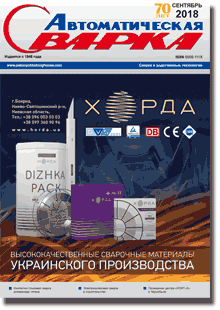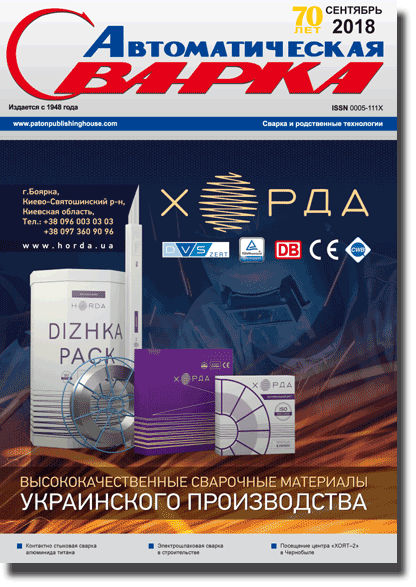| 2018 №09 (02) |
DOI of Article 10.15407/as2018.09.03 |
2018 №09 (04) |

Avtomaticheskaya Svarka (Automatic Welding), #9, 2018, pp. 17-22
Characteristics of structural strength of d16t alloy welded joints,
A.G. Poklyatskii1, Yu.V. Golovatuk2, T.M. Labur1, O.P. Ostash2, S.I. Motrunich1
1E.O. Paton Electric Welding Institute of the NAS of Ukraine. 11 Kazymyr Malevych Str., Kyiv, 03150. E-mail: office@paton.kiev.ua
2G.V. Karpenko Physico-Mechanical Institute of NASU, 5 Nauchnaya Str., Lvov, 79060
A series of research was performed to study the characteristics of structural strength of butt joints of aluminium alloy D16T 2 mm thick, produced by friction stir welding. Features of weld formation and degree of metal softening in the zone of the produced permanent joint were analyzed. Mechanical testing of welded joint samples was performed at static and cyclic loading. Diagrams of fatigue cracks growth rate in the base metal, heat-affected and thermomechanical impact zones, on the boundary of these zones and in the weld metal were plotted. It is shown that the characteristics of cyclic crack resistance of weld metal of these joints are more than two times higher than the respective values for base metal that is indicative of the good prospects for application of friction stir welding in fabrication of critical structures from D16T alloy. 19 Ref., 8 Fig.
Keywords: aluminium alloy D16T, friction stir welding, microstructure, cyclic crack resistance, structural strength
Received: 09.07.2018
Published: 20.09.2018
References 1. Beletsky, V.M., Krivov, G.A. (2005) Aluminium alloys (composition, properties, technology, application): Refer. Book. Ed. by I.N. Fridlyander. Kiev, Komintekh [in Russian].
2. Ishchenko, A.Ya., Labur, T.M., Bernadsky V.N., Makovetskaya, O.K. (2006) Aluminium and its alloys in modern welded structures. Kiev, Ekotekhnologiya [in Russian].
3. Ostash, O.P. (2015) Fracture mechanics and strength of materials: Refer. Book. Ed. by V.V. Panasyuk. Vol. 15: Structure of materials and fatigue life of structural elements. Lviv, SPOLOM [in Ukrainian].
4. Romaniv, O.N. (1979) Fracture toughness of structural steels. Moscow, Metallurgiya [in Russian].
5. Ostash, O.P., Gajvoronsky, O.A., Poznyakov, V.D., Kulyk, V.V. (2016) Method of heat treatment of high-strength lowalloy carbon steels. Pat. 105440, Ukraine. Publ. 25.03.2016 [in Ukrainian].
6. (1998) Joint Aviation Requirements, JAR 25.571.
7. Lozovskaya, A.V., Chajka, A.A., Bondarev, A.A. et al. (2001) Softening of high-strength aluminium alloys in different fusion welding processes. The Paton Welding J., 3, 13�17.
8. Poklyatsky, A.G., Ishchenko, A.Ya., Grinyuk, A.A. et al. (2002) Non-consumable electrode argon-arc welding of aluminium alloys with arc oscillations. Ibid., 2, 18�22.
9. Poklyatsky, A.G., Grinyuk, A.A. (2001) Effect of parameters of asymmetric and modulated currents on quality of aluminium alloy welded joints. Ibid., 7, 33�36.
10. Poklyatsky, A.G. (2001) Peculiarities of formation of macroinclusions of oxide film in weld metal of aluminium alloys (Review). Ibid., 3, 36�38.
11. Ishchenko, A.Ya., Lozovskaya, A.V., Sklabinskaya, I.E. (1999) Mechanism of retardation of solidification cracks in welding of aluminium alloys with scandium. Svarka, 8, 13�16 [in Russian].
12. Thomas, W.M., Nicholas, E.D., Needham, J.C. et al. Friction stir butt welding. Int. Pat. PCT/GB 92/02203; GB Pat. Appl. 9125978.8. Publ. 1991.
13. Pietras, A., Zadroga, L., Lomozik, M. (2004) Characteristics of welds formed by pressure welding incorporating stirring of the weld materials (FSW). Welding International, 1, 5�10. https://doi.org/10.1533/wint.2004.3215
14. Shibayanagi, T. (2007) Microstructural aspects in friction stir welding. of Japan Inst. of Light Metals, 9, 416�423.
15. Ishchenko, A.Ya., Poklyatsky, A.G. (2010) Tool for friction stir welding of aluminium alloys. Pat. 54096, Ukraine. Publ. 25.10.2010 [in Ukrainian].
16. Ostash, O., Uchanin, V., Semenets, J. et al. (2018) Evaluation of aluminium alloys degradation in aging aircraft. Research Nondestructive Evaluation, 29(3), 156�166. https://doi.org/10.1080/09349847.2017.1302622
17. Standard test method for measurement of fatigue crack growth rates. ASTM Standards, E647-93.
18. Bussu, G., Irving, P.E. (2003) The role of residual stress and heat affected zone properties on fatigue crack propagation in friction stir welded 2024-T351 aluminium joints. J. Fatigue, 25, 77�78. https://doi.org/10.1016/S0142-1123(02)00038-5
19. Aydin, H., Bayram, A., Durgun, I. (2010) The effect of postweld heat treatment on the mechanical properties of 2024-T4 friction stir-welded joints. Des., 31, 2568�2577.
The cost of subscription/purchase order journals or individual articles
| Journal/Currency | Annual Set | 1 issue printed |
1 issue |
one article |
| TPWJ/USD | 384 $ | 32 $ | 26 $ | 13 $ |
| TPWJ/EUR | 348 € | 29 € | 24 € | 12 € |
| TPWJ/UAH | 7200 UAH | 600 UAH | 600 UAH | 280 UAH |
| AS/UAH | 1800 UAH | 300 UAH | 300 UAH | 150 UAH |
| AS/USD | 192 $ | 32 $ | 26 $ | 13 $ |
| AS/EUR | 180 € | 30 € | 25 € | 12 € |
| SEM/UAH | 1200 UAH | 300 UAH | 300 UAH | 150 UAH |
| SEM/USD | 128 $ | 32 $ | 26 $ | 13 $ |
| SEM/EUR | 120 € | 30 € | 25 € | 12 € |
| TDNK/UAH | 1200 UAH | 300 UAH | 300 UAH | 150 UAH |
| TDNK/USD | 128 $ | 32 $ | 26 $ | 13 $ |
| TDNK/EUR | 120 € | 30 € | 25 € | 15 € |
AS = «Automatic Welding» - 6 issues per year;
TPWJ = «PATON WELDING JOURNAL» - 12 issues per year;
SEM = «Electrometallurgy Today» - 4 issues per year;
TDNK = «Technical Diagnostics and Non-Destructive Testing» - 4 issues per year.





